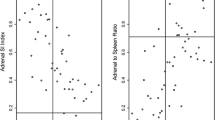Abstract
Purpose.
The objective of this study was to evaluate the diagnostic accuracy of chemical–shift (CS) magnetic resonance (MR) imaging in the differential diagnosis of adenoma and nonadenoma adrenal masses.
Materials and methods.
We enrolled 36 patients (9 men, 27 women, mean age 51.3+14.4 years) with unilateral (n=31) or bilateral (n=5) adrenal masses incidentally discovered during imaging examinations [ultrasound (US), computed tomography (CT)] performed for other indications. A total of 41 adrenal lesions were evaluated (mean diameter 3.0+2.2 cm). Histology (n=19), biopsy (n=3) or clinical–imaging follow–up (n=19) demonstrated 29 adenomas, five pheochromocytomas, three cysts and four carcinomas. MR imaging was performed using the following breath–hold sequences: T1–fast field echo (FFE) [repetition time (TR)/echo time (TE)=236/4.6 ms], T2–turbo spin echo–single shot (TSE–SSh) (TR/TE=831/80 ms), T1–DUAL–FFE (TR=236, double TE=4.6/2.3 ms in phase and out of phase) and T1–FFE after gadolinium–DTPA (Gd). Axial and coronal imaging planes were used, with a slice thickness of 3–5 mm. MR images were qualitatively assessed for signal intensity of the adrenal mass relative to the liver on T1, T2, CS and T1–Gd scans; diagnostic criteria for adenomas were isointensity or hypointensity on both T1 and T2 scans, out–of–phase CS signal loss and mild transient enhancement after Gd.
Results.
Analysis of T1–T2 signal intensity showed diagnostic accuracy, sensitivity, specificity, positive predictive value (PPV) and negative predictive value (NPV) of 80%, 72%, 100%, 100% and 60%, respectively. In contrast, analysis of CS and T1–Gd signal intensity showed diagnostic accuracy, sensitivity, specificity, PPV and NPV for both sequences of 93%, 90% (p<0.05 vs. T1–T2 analysis), 100%, 100% and 80% (p<0.05 vs. T1–T2 analysis), respectively.
Conclusions.
CS MR imaging significantly improves characterization of adrenal masses compared with conventional T1–T2–weighted images, providing accuracy similar to that of the T1 sequence after Gd. Therefore, the CS sequence is strongly recommended for MR study of adrenal masses, and its use might obviate the need for Gd administration.
Similar content being viewed by others
Author information
Authors and Affiliations
Corresponding author
Rights and permissions
About this article
Cite this article
Maurea, S., Imbriaco, M., D’Angelillo, M. et al. Diagnostic accuracy of chemical-shift MR imaging to differentiate between adrenal adenomas and non adenoma adrenal lesions. Radiol med 111, 674–686 (2006). https://doi.org/10.1007/s11547-006-0065-9
Received:
Accepted:
Published:
Issue Date:
DOI: https://doi.org/10.1007/s11547-006-0065-9




